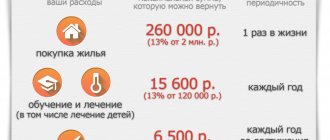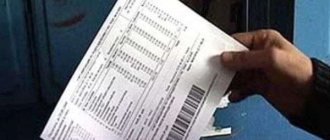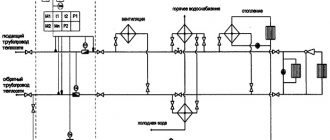Monetary benefits allocated by state budgets of different levels and specialized funds, aimed at improving the living conditions of certain categories of citizens or providing them with material support when paying for utilities, is called a subsidy. We'll talk about it further.
When the purpose of material support is precisely to improve living conditions, these are housing subsidies. This assistance measure is free of charge. It is not subject to taxation as income of an individual or return to the budget.
Categories
Housing subsidies are divided into two categories:
- Financial assistance aimed at compensating part of citizens’ costs for utility bills.
- Assistance aimed at co-financing when purchasing a home or building a house.
The legal regulator, which enshrines provisions obliging the state to provide subsidiary assistance to certain categories of citizens, is the Housing Code of the Russian Federation. The legislation also establishes the requirements that citizens must meet in order to be included in the list of those who are entitled to material support from the state. The formation of such lists and the subsequent issuance of subsidies are carried out by local authorities.
What is a subsidy?
Nowadays, at every step you can hear help received from the budget by individuals and legal entities. Such support can take many forms, but the concept of subsidization is often used.
A subsidy is a budget payment aimed at supporting people in need. Such persons are not only citizens, but also enterprises of various forms of ownership, and even the budgets themselves.
There are 2 levels of subsidies:
- interbudgetary – assistance from the state budget to the local one;
- targeted assistance to legal entities and individuals.
In simple words, the mechanism of interaction between government entities (the first level of subsidies) can be explained as follows. In the body of the state, everything is interconnected. There is a clear administrative system - there are several budgets at various levels that ensure the collection of taxes and duties for transfer to the main (federal) budget. But, of course, the regions are not equal in their potential. There are profitable areas, and there are administrative-territorial units that require special attention and support.
When money from lower budgets enters the state budget, the funds are redistributed among poor regions, thus equalizing the economic situation. Additional payments in the form of assistance are subsidies. They are allocated strictly for specific purposes (for example, to support a large enterprise); the money is not refundable. Because of this system of additional payments, subsidies are usually called additional financing or co-financing, that is, joint financing of projects by the state and the local budget.
The same thing happens with the redistribution of taxes and income of individuals. There are categories of the population that frankly need help. What is government subsidization of citizens? This is social support aimed at full or partial payment for services and purchases provided to individuals. Local authorities arrange assistance, although the money is allocated directly from the state budget.
Social assistance programs can also be adopted at the regional level. They are approved and implemented by local administrations.
Certificate for receiving a subsidy
Despite the differences depending on the region of the country, the common thing is the issuance of a certificate for receiving a housing subsidy. The document has a deadline. That is, its action is limited in time. It is also important to know that a document confirming the right to receive a subsidy cannot fully compensate for the required amount for purchasing a home. Thus, the necessary condition becomes:
- Availability of your own residential premises, which can be sold in the future in order to add the amount received from the transaction to the funds under the certificate.
- Availability of own accumulated funds.
The certificate can be used as:
- down payment when applying for a mortgage;
- payment of the balance of the principal debt on an existing housing loan;
- contribution to a share upon joining a housing construction cooperative;
- in some cases, use it to expand an existing apartment or renovate it to improve living conditions.
After receiving the certificate, its validity period is only six months. During this time it must be implemented. Otherwise, you will have to stand in line on a general basis. It is also important to know that the document can only be used once.
Who is eligible?
Registration of a housing subsidy, be it the purchase of housing or payment of utilities, is available only to those categories of citizens defined by legislative acts. Persons who are entitled to a subsidy to pay for housing and communal services include:
- large families;
- persons living in apartment buildings;
- members of housing cooperatives;
- renters;
- persons occupying residential space under a social tenancy agreement;
- retired people;
- citizens living in one place for more than five years.
How to calculate the subsidy amount?
To calculate the amount of subsidy you are entitled to, you must take into account the following indicators:
- regional tariff;
- the maximum allowable percentage of payment;
- total family income.
There are four established standards (tariffs). The first is provided for those persons who are tenants of housing under the terms of a rental agreement. The second is designed for those who rent housing under a social tenancy agreement, that is, they already have certain benefits. The third standard applies to owners of residential premises who are required to pay a fee for major repairs, and the fourth standard applies to those who are exempt from such obligation.
Moscow's participation in housing and utility costs
As an example, we can provide data relevant for Moscow as of July 2020. They are reflected in the table:
| Category of citizens | 1 | 2 | 3 | 4 |
| lonely people | 3 982,47 | 3 591,09 | 3 980,82 | 3 485,82 |
| family of two (per person) | 3 088,29 | 2 839,23 | 3 087,24 | 2 772,24 |
| family of three or more people (per person) | 2 871,46 | 2 657,98 | 2 870,56 | 2 600,56 |
Subsidy for the purchase of housing. Who is eligible?
The category of those who can count on state assistance when purchasing housing is determined by the following list:
- families in which the spouses are under 35 years old, the absence of children is not an obstacle;
- military personnel and employees of various departments, including those who have already retired from service;
- citizens who have lived in the Far North of Russia for at least 15 years;
- WWII veterans;
- people with an established disability group;
- families with three or more children;
- low-income families;
- Chernobyl survivors and combatants.
Who can apply for a housing subsidy?
The current legislation clearly defines the categories of citizens who have the right to apply for a housing subsidy. It can be:
- Families with three or more children who have not reached the age of majority (if the child is already 18 years old, but the child is studying full-time at a university or is undergoing military service upon conscription, then the age limit for receiving financial assistance is raised to 23 years).
- Young families, when the age of the spouses does not exceed 30 years.
- Low-income families in need of their own housing.
- Military personnel, including those transferred to the reserve.
- Civil servants, as well as public sector employees.
- Young specialists who moved to villages to work at agricultural enterprises (having previously received appropriate education in this field).
- WWII participants and their families.
- Orphans, as well as children left without parental care.
The categories of citizens listed above have the right to apply for a housing subsidy if, at the time of submitting documents, they are considered to be in need of improving the conditions of their current housing.
How is it calculated?
Who is entitled to a housing subsidy and how to calculate its amount? It is determined by government agencies. When calculating the amount of a housing subsidy, the two most important criteria are taken as the basis:
- the average cost of one square meter in a particular region of the country;
- the legally established standard of living space per person.
When determining the final amount of subsidy allocated for the purchase of housing, all real estate owned by the family is taken into account. That is, each family member is required to provide information about the housing they own or rent.
Receiving assistance from the state is of an application nature. That is, it is necessary to submit a petition in the prescribed form. A package of documents is attached to it. The list included in it can be clarified by the authority that is responsible for allocating subsidies. In the future, all documentation will be transferred for consideration by a special commission. It will determine the amount of financial gratuitous assistance.
Separately, it can be noted that the amount of assistance depends on a large number of factors. That is, in addition to the previously noted conditions, the following is also taken into account:
- the category to which the applicant belongs;
- number of people in the family.
- coefficient for adjusting the amount of the subsidy, depending on the category of the applicant.
It is important to understand that the correction factor is affected by:
- duration of civil service;
- work experience in the agro-industrial center;
- duration of military service;
- number of years on the waiting list for housing.
How is the amount of assistance calculated?
This procedure is carried out exclusively by government agencies. At the same time, they are obliged to take into account the standards established at the regional level regarding living space standards. This indicator, in turn, affects the cost of utilities and, of course, the final amount of the subsidy.
The approval of regional standards is carried out in accordance with such indicators as:
- cost of using living space;
- quality and level of housing improvement;
- characteristics and parameters of the structure;
- established utility tariffs;
- utility consumption standards;
- housing management costs for maintaining houses, as well as carrying out repair work.
In order to correctly calculate the amount of the subsidy, you should use a special formula that is established at the legislative level.
Subsidy calculation
It is important that the final value does not exceed the actual costs of paying for utilities.
Standard housing area per person
It is worth mentioning separately that the standard housing area established by law is determined by:
- one person – 36 m2;
- two people – 50 m2;
- for three – 70 m2;
- a family of 4 people can count on 85 m2;
- if there are more than five in the family, then each person should have eighteen square meters.
These standards can be changed downward if:
- the commission will find that the established requirements for living space are exceeded;
- The applicant aims to expand the occupied area.
It is known that the city housing subsidy, as a rule, amounts to 30% of the total cost of the property, for areas outside the city - approximately 60%. An increase in the amount is also allowed in certain situations and subject to availability. However, you should not count on an amount of more than 70%.
Package of documents for receiving subsidies
You can start applying for a subsidy by visiting the city housing subsidy center or another body responsible for government assistance. It is here that you can clarify the entire list of documents required for consideration of the application, which includes:
- Identification.
- Document confirming work activity, with a certified copy.
- Title and title documents for the occupied area.
- A document confirming the right to expand living space.
- An extract from the house register and personal account.
- Documents confirming the applicant's marital status and certifying the birth of children, if available.
- Identification of everyone who lives with the applicant.
What is housing subsidy?
A housing subsidy is a cash benefit that certain categories of Russian citizens can receive from the state or local budget, as well as from specialized funds.
The main purpose of this subsidy is financial support for a certain category of people. The housing subsidy is provided absolutely free of charge and does not imply a return of funds back to the budget.
Two types of subsidy assistance from the state can be provided:
- Housing subsidy to pay utility bills;
- Subsidy for the purchase of living space or construction of a private house.
Refusal to receive
In this case, the applicant may be refused by the city center for housing subsidies if a deliberate deterioration of living conditions is detected. Such actions include:
- Reducing living space by exchanging.
- Registration of additional persons for living space.
- Sale of a part or share in an occupied residential property.
The following may also be grounds for refusal to issue a subsidy:
- independent solution of the housing issue;
- deprivation of beneficiary status due to deregistration;
- hiding information about changes in work or family composition.
When purchasing housing with a subsidy, an important aspect is its legal purity. That is, it should not be on bail, under arrest, etc.
Types of subsidies
The legislation of the Russian Federation applies a number of types of subsidies. This:
- targeted;
- according to form;
- subsidized loans;
- business assistance;
- assistance to agriculture.
The concept of a subsidy has evolved over time and in the modern sense has acquired a complex form. Below we will consider what each of these types is.
By shape
Subsidies are also divided into types according to their form. This:
- direct - this means a specific amount of money or other valuables transferred to the subsidized entity (textbooks for school, machines for a factory, etc.);
- indirect - expressed in tax benefits, reduction of interest rates, discounts on rental premises, etc.;
- cross – when one region (economically weak) is subsidized at the expense of another (with significant economic indicators).
Target
Subsidies may be targeted. In this aspect, two varieties are considered:
- Aimed at supporting promising projects. Money is transferred into the hands of innovative scientists, business representatives, researchers, writers, composers and other citizens who can influence culture and progress. It is assumed that the funds thus spent will be put to good use and will give rise to discoveries, literary or musical works, enterprises, etc.;
- Aimed at providing assistance to socially vulnerable citizens. The law provides for such categories as large families, low-income people, young families, disabled people, pensioners, citizens working in certain fields of activity or who have contributed to the development of society or the state. The source is either the state or the regional budget. In the first case, the recipients are representatives of certain categories living in any region, in the second - citizens of a certain region that allocated funds for subsidies. Assistance may relate to improving living conditions, treatment, payment of housing and communal services, travel, etc.
Agriculture subsidies
Subsidized lending
Taking out loans has become the norm in our society.
Most families in the Russian Federation purchased an apartment or car on credit. Sometimes citizens are forced to take out a loan for treatment. Every year, more and more often, young people and their parents turn to banks to receive financial assistance for entering a university at a paid faculty. The most common object of subsidization is mortgage lending. For this type of loan, there is a special procedure for providing subsidies - citizens have the right to take a tax deduction, which will help make the apartment more affordable, and the burden associated with paying interest is not so heavy.
Federal and regional legislation has programs that allow you to lease domestic cars. This direction has eligibility criteria, that is, the borrower or vehicle must meet certain conditions. For example, a car should not cost more than a certain amount.
Subsidies for loans support, on the one hand, subsidized citizens, and on the other, construction companies, car manufacturers, and the banking sector.
Business subsidies
Support is needed not only for individuals or families. Often entire organizations need help. The state is interested in business development, discoveries being made, and the economy growing. However, not every enterprise can afford to modernize production by purchasing new expensive equipment and materials. Not all novice businessmen can stay afloat, given the prices of equipment and taxes.
Funds are allocated from the federal and local budgets to assist organizations and start-up businessmen. These are subsidies, the result of which will have a positive impact on society and the country in the future.
In order to identify the most promising recipients of subsidies, competitions are organized. To participate in them, applicants must prepare a detailed plan indicating the purposes for which injections from the local or federal budget are needed.
Agriculture subsidies
The state is interested in the development of both industry and agriculture. Every year, money is allocated from the budget to support livestock and crop production.
Mortgage repayment subsidy
The agricultural sector is the most important for the state. Its development allows us to completely saturate the market with food products. Thanks to its development, new jobs are created.
Agriculture is one of the most unstable industries, as it depends on weather conditions. Pests, droughts and heavy rains annually reduce the expected level of harvest and even ruin some farms. Subsidies in this area are aimed at supporting agricultural producers, and with them society.
In the field of agriculture, various types of subsidies are used:
- preferential loans;
- preferential insurance;
- one-time assistance for the purchase of agricultural machinery;
- gratuitous funds for the purchase of fertilizers, seeds, and construction of buildings.
Thanks to agricultural subsidies, economic indicators are growing in a promising but underdeveloped sector of the national economy for Russia.
Subsidies for military personnel
Housing subsidies for military personnel make it possible to provide those who gave their lives in serving their homeland with living space. Its advantage is that military personnel cannot be dismissed until they are provided with their own housing. In this case, dismissal from a position is possible only at one’s own request.
Housing subsidies for military personnel are available subject to certain conditions:
- Availability of a valid contract concluded before 1998.
- Recognition of those in dire need of housing.
- If you have ten years of service, if the military man was dismissed for health reasons or organizational reasons.
- Reaching the age limit.
- Having twenty years of experience living in a service apartment.
Receiving assistance in purchasing housing for military personnel is possible only if they are registered as a person requiring improved living conditions. For this purpose, a package of documents is submitted. It includes:
- ID card for all family members;
- documents confirming the birth and/or adoption of children;
- confirmation of official marriage;
- a document confirming the employment and length of service of a military man;
- an extract from the house register and financial personal account for the last five years.
The list can be expanded as necessary. After submitting documents, they are reviewed within twenty days. After which a decision is made on inclusion in the general register or refusal.
We apply for a housing subsidy
After receiving the “low-income” status, you can begin applying for a housing subsidy. Family members may be recognized as needing to improve their living conditions if at least one of the following conditions is met:
- the family does not use housing under a social rental agreement;
- the family does not own residential premises;
- the premises in which family members live are officially recognized as unsafe;
- a seriously ill person with an incurable disease (for example, tuberculosis) lives with his family;
- the family has housing, but the minimum space requirements per member are not met.
How to get a subsidy? First of all, you need to submit a package of documents to the housing subsidies department - a local government body. As a rule, you will need to bring a passport, certificates from the house register and BTI, certificates from the cadastral and registration chambers, which confirm the absence/presence of residential premises in the property. After submitting the documents, the commission will make a decision within 30 days on whether or not to register a family in need of improved living conditions.
If the decision is positive, the administration will issue a document and assign a number in the queue. Now you just need to wait (unfortunately, the wait can take from six months to ten or more years). Although in some cases it is possible to receive an extraordinary housing subsidy. This applies to people suffering from serious illnesses and in need of separate housing, as well as those living in dilapidated buildings that cannot be repaired or reconstructed.
Calculation of subsidies for the military. How does it happen?
The calculation of subsidies for the military is based on:
- the size of the area allocated to the military man and his family members;
- average cost per square meter in the region of purchase;
- coefficient depending on the serviceman's length of service.
Assistance is provided one-time and one-time. For information, it is worth knowing that the coefficient is determined according to the following rules:
- ten to sixteen years of experience – 1.85;
- sixteen years of experience – 2.25;
- 20-21 years of experience – 2.375;
- experience more than 24 years – 2.45.
The final calculation of housing subsidies for military personnel is made when funds are transferred on a specific date. This program is distinguished by the fact that it covers 80% of the costs of purchasing real estate within the established norm, in contrast to subsidies for civilians.
The issuance of funds is possible only with an official application, by writing an application to the housing authority of the Ministry of Defense of the Russian Federation. Military personnel must open a bank account to service the subsidy and submit its details to the housing authority with an application to transfer the monetary payment to the military man to his personal account to pay for the purchased real estate under the contract.
Deadlines for transferring funds
Regarding the deadlines for transferring funds, the regulations are as follows:
- after receiving the application, the military’s availability of living space is checked, this takes 10 days;
- after the verification activities have been completed, a decision is made to issue a subsidy within 10 days;
- one copy of the decision is sent to the financial department, the second to interested parties, this takes another three days;
- The period for receiving funds to the military should not be more than 30 calendar days.
Considering this stretch of time, at the time of purchasing a home, it makes sense to carry out the necessary preparatory measures and inform the seller about all the nuances associated with payment for the transaction.
Housing and communal services. Who can receive the subsidy?
Along with assistance in improving housing conditions, the state has provided significant support for its citizens in paying for utilities. This kind of assistance is called housing and communal assistance. Some categories of citizens can receive a subsidy for housing services in accordance with the law. These include:
- owners of residential premises, regardless of whether it is an apartment or a room;
- tenants who occupy the space legally (social tenancy or rental agreement);
- member of a housing cooperative or housing cooperative.
Who can apply?
In accordance with the norms of the current housing legislation, the following categories of citizens have the right to receive subsidies:
- members of residential cooperatives;
- owners of private houses;
- persons who live in housing provided to them by the state;
- tenants.
When can you apply for a subsidy?
The most important thing that is taken into account when calculating a subsidy is the size of a person’s income. If they are significantly lower than the cost of paying for utilities, a person has the right to receive a benefit.
What documents are needed? Required conditions for receiving
Housing and utility subsidies are available by contacting the Social Security Administration with the established list of documents attached to the application:
- Applicant's identity card.
- Passports of all members of his family.
- Papers confirming the right to occupy the living space specified in the application.
- A document confirming earnings for the last six months.
- Documents confirming the absence of utility debts.
- An extract from the house register, financial personal account and a certificate of family composition.
- Bank details.
Submitted documents are reviewed within 10 working days. After which a decision is made. If it is positive, subsidies are assigned either from the first day of the month or from the 16th day of the month for a period of 6 months. Then you must submit all documents again. At the time of application, to receive a subsidy for housing and communal services, the following prerequisites are:
- presence of Russian citizenship;
- absence of debts for services;
- lack of an agreement to repay existing utility debts.
Where to apply for registration?
To receive such assistance from the state, you must submit a certain list of papers to the appropriate authority.
Before doing this, you should prepare the following documents:
- Statement of the established form. Its text must indicate the name of the government body whose powers include assigning the amount of the subsidy. You should also indicate the applicant’s passport and contact details, the composition of the family that lives in this living space, and their personal information. Do not forget to mention the full address and details of the bank account to which the funds will be credited.
Subsidies for housing and communal services
- Passports of all family members you mentioned in the application. Make a few photocopies (just in case) and take the originals with you.
- A purchase and sale agreement, gift or any other document confirming your ownership rights to this real estate.
- Certificate of family composition. You can get it from the housing office at your place of residence.
- Personal account statements confirming that you pay utility bills and have no debts.
- Certificates of income for each family member for the last six months.
Subsidy amount. How to calculate?
The amount of the allocated subsidy is determined based on:
- housing size;
- the amount of repair work and maintenance of the house;
- prices for heat and water supply;
- cost of sewerage services;
- the size of tariffs for electricity and gas supply.
As a nuance, it can be noted that the incomes of citizens throughout the country differ, therefore the legislation has established the maximum amount of allowable expenses for paying for housing and communal services from the total family income. Today this figure is 22%.
It was also taken into account that tariffs for services vary in different regions. To determine the amount of subsidies, prices for all services provided are summed up. However, the procedure for providing financial assistance also differs from region to region. In addition, the calculation of subsidies for certain categories of citizens (combatants, disabled people, WWII veterans and children, large families, orphans, low-income people and former government employees) may differ.








